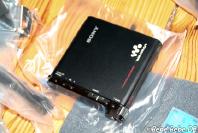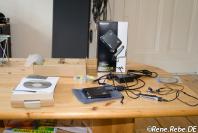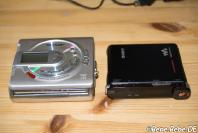Sony MZ-RH 1 MD-Walkman review
My first contact with the Sony MiniDisc format was in the mid 90th. At that time I have been a bit more active palying guitar and bass and the Mini-Disc was a perfect medium to not only record some jam sessions or concerts but also carry the tiny player with other pre-recorded music around when others either had big, skipping CD-players or grinding and noisy analog tape walkmans. Despite a Yamaha MD HIFI deck I have the portable Sharp MD recorder. The later, now nearly 10 years old, is still in perfectly function after it was in use for 3 years when I was an trainee, for music yam sessions, I even borrowed it to a friend who studied composing and it made it to Ireland on a three week bicycle tour.
I never brought one of those MP3 player, whether iPod or other low-quality incarnations, because the ability to record is too handy and those mp3 player can not form the base for a music collection. At some time the hard-disc, or even sooner the flash, is filled up. MDs can be collected nicely among the CDs - and hundreds of them.
Now that Sony released a High density, Hi-MD format, including the possibly to store arbitrary data as well as inject MP3 tracks caught my attention. With the announcement of the MZ-RH 1 MD-Walkman it was the time to give that promising product a try:
The MZ-RH1 comes with quite a lot of paper work, the left side bunch are manuals in several languages, the cable remote, usb cable, and since the device has only a USB connector - not a dedicated power-supply plug, a power supply with a usb connector to charge the battery independent of a computer.
Overall the device looks very stylish and professional, especially the jog-wheel with play and record button and the OLED display. Compared with my former Sharp recorder it is much thiner and way lighter.
Usability wise it is as intuitive as usual, the jog wheel is used for navigation and fast forward / rewind in tracks, and as usual for MD recorders you can move, split, combine tracks on the fly, edit titles and so on.
The cable remote is a bit disappointing, it looks a bit cheap, plastic-wise, and lacks viewing angle. Also just because of this limitation I had to notice the device display does not allow to show the track names - maybe because the device has two separate displays and some Sony engineer decided the gab inbetween would be too big for scrolling text …
With a Hi-MD formatted disc the recorder appears as normal USB storage device and thus is accessible from any OS: Linux, Mac OS, Windows to name a few. However the old, classic MDs are only accessable from within the Sony SonicStage software - not even from the Mac software shipped with the package. Also SonicStage is not able to play the old MD tracks in real-time, instead the recorder will play the track out of the headphone / line-out if requested to play in the software, however it is still possible to copy those tracks back to the PC.
To upload audio tracks, be that MP3 or ATRAC files, the device should be able to play, meta data updates in special files of the Hi-MD medium are required, just drag’n dropping the files is not enough. SonicStage is required to register the files properly - not even the Hi-MD Transfer for Mac allows this, however it is just a matter of time until some open source developer will figure out how to update the meta data accordingly - as it was case for the Apple iPod as well …
All in all it is a awesome portable recorder that should be quite a pleasure to use for the next years, the music can be collected on a shelf while the 1GB media is still large enough to allow a current “personal best of” to be carried around as one would do with other MP3 players.
The quality of the headphone / line-out is exceptional perfect, and a menu option allows raising the level to the standard line level. I still wonder why in contrast the Sony walkman “cell phones” produce clicks and clacks between some mp3 files that make your ear wanna die with a far from linear output frequency spectrum.
The use as ordinary data storage is a much welcomed extra that might, or should suspend my 250MB Zip - random access CD / DVD media is still not widespread either. However the Sony DRM is really a drawback, especially with not even Mac software to transfer music onto the player. (I need to figure out the meta-data to up and download the tracks under Linux, however a first glimpse indicate that will not be that easy …)
Update:
The self discharge is quite high. When it is on stand-by for about a week the Li-Ion battery is about empty.
Update 2016:
Unfortunately the OLED display apparently die after some time. Since the “o” in OLED actually stands for organic, I personally call this “rotting away” displays. Sigh.
It is however possible to find those spare parts sometimes, and replace it with a lot of time and patience: Replacing the OLED EL-display on a Sony MZ-RH1
As far as I have found out the same part: 1-802-022-11, Indicator Module, Organic EL, is also used in at least the Sony NW-S202, S203, S205 and NW-E305, E307.
Update 2017
Now that I can upload mp3 from Linux I accidentally realize the MZ-RH1 refuses to play 48kHz files :-/ Apparently the decoder or DAC is limited to 44.1kHz.
Update 2018
Now with OLED swap video series!




September 8th, 2006 at 10:41
I’ve a question: If i drop mp3 file into Hi-MD in UsbStorage mode, can the walkman read them ?
September 8th, 2006 at 11:22
No. The audio data must be written in special files and registered in low-level control files and is normally 3DES encrypted with a per-disc key. Sony’s SonicStage is the only applicaton able to do this right now. But I started some open source bits to do the same but it is at the very beginning.
June 21st, 2007 at 19:49
I know this can record wav. If I record wav can I retrieve the files (Hi MD) through USB, in Linux, without extra software?
greets
June 22nd, 2007 at 10:12
Not without extra software. The data is all stored in the “raw sectors” with the space marked allocated in the filesystem FAT (File Allocation Table).
In the mentioned open source code I already have some lines (of code) to parse the track table, and I know in priniple where the data is stored, but as I focused on getting the music encrypted and decrypted did not bother about the raw PCM so far (and I did not worked on the whole thing in the past half a year anyway as I do not have much free time at the moment).
If Sony does not encrypt the raw PCM, I might be able to get that out of the disc with the current code and some hours of cutting the raw data sectors together.